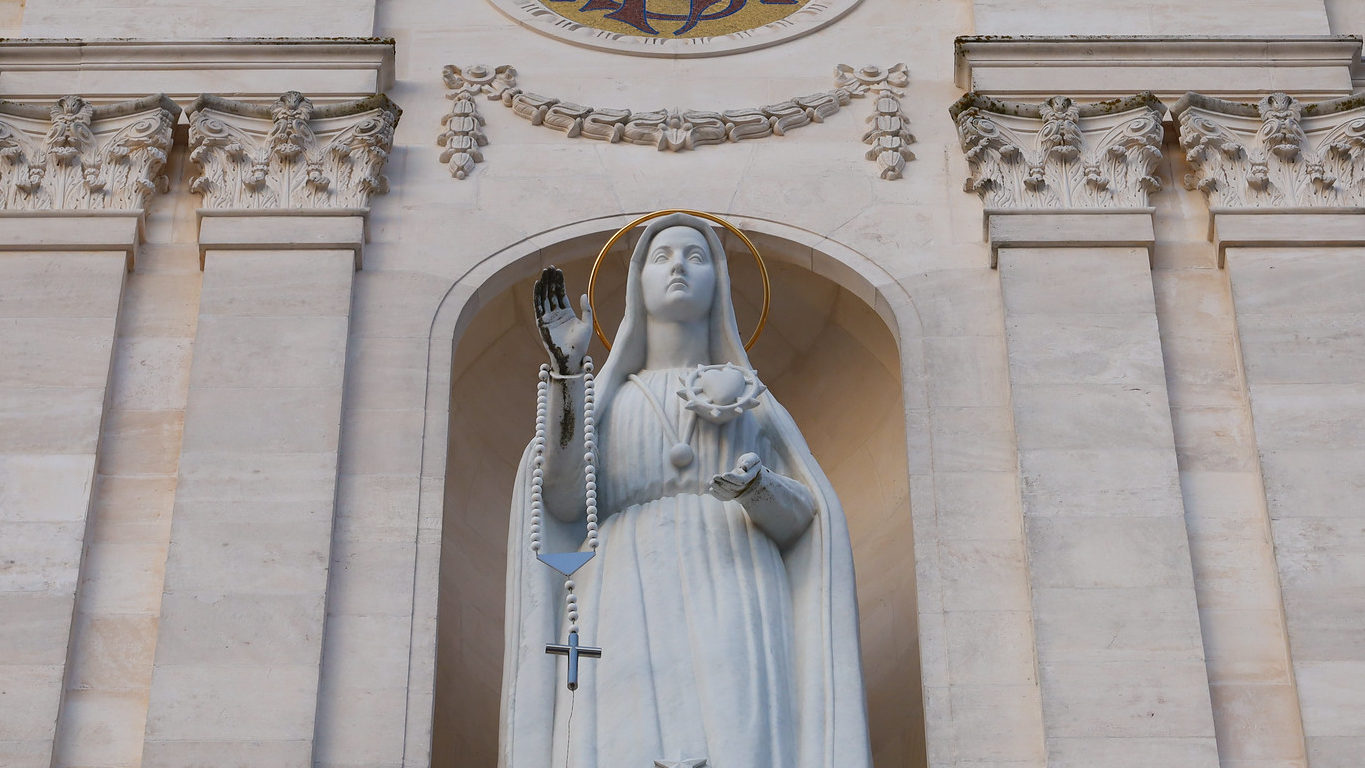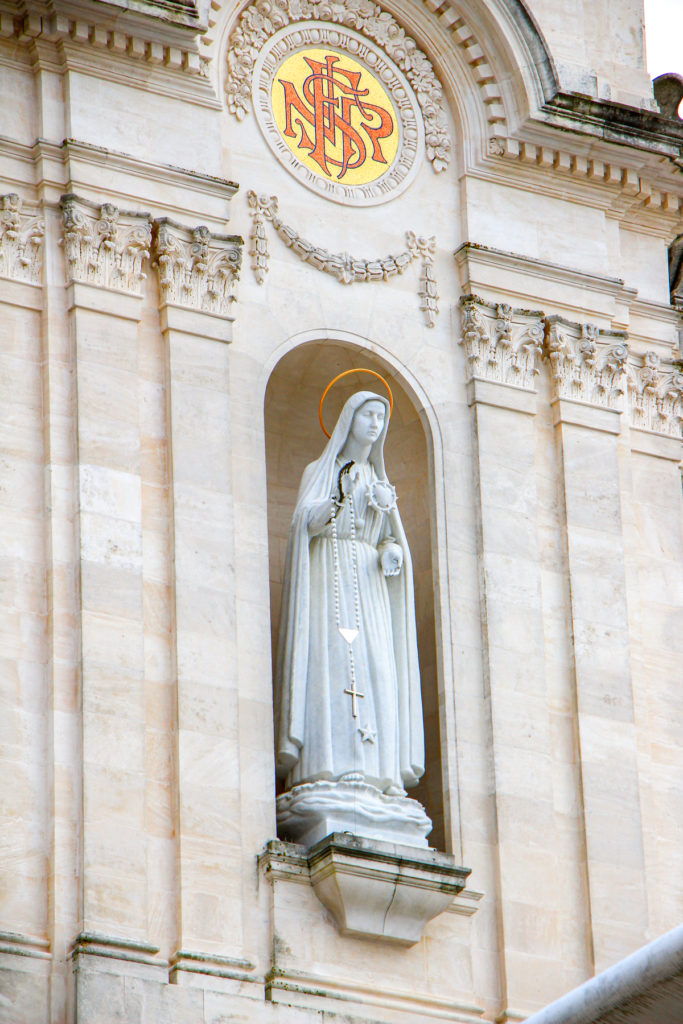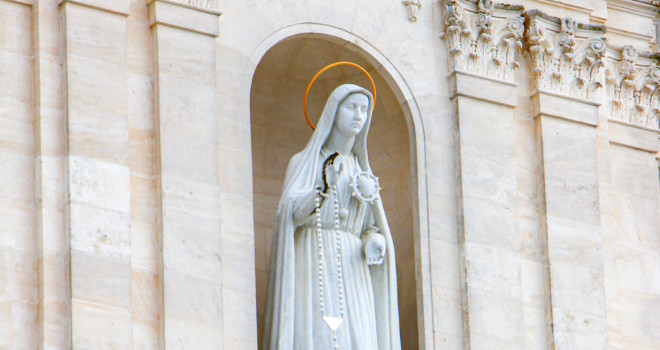Fatima’s Shepherd Girl and the Artist Monk – Part IV
This series illustrates the making of the American statue of the Immaculate Heart of Mary in Fatima, which has decorated the bell tower of the Basilica of the Rosary since 1958. In Fr. McGlynn’s statue, we see how the shepherd girl Lúcia herself saw Our Lady at Fatima. In the fourth episode, the artist monk meets Lucía, often called Irmã Dores. His model, however, failed to earn her approval. Their conversation contains less-known aspects of Fatima and is a record of what has actually happened.
The Child from the Mountains
The wise Mother Provincial of the Dorothean Sisters in the Colégio do Coração Sagrado de Jesus do Sardão in Vila Nova de Gaia noticed the nervousness of the self-confident Dominican monks that they were both striving bravely to conceal. Kindly, she tried to put them at their ease. “There is nothing to be disturbed about. Irmã Dores is very simple; she is a child of the mountains.” She assured them that Lucy would willingly answer all their questions.
With all his preparations and travels, with all the desire Fr. McGlynn had to see Lucía, he thought at that moment he would prefer to be in a comfortable chair in his mother’s apartment in New York. In a moment, there would walk across the threshold a woman who knew some of the secrets of heaven, who had seen and talked with the Blessed Virgin, to a person favored by God beyond all others living and charged by Him to be the instrument of a divine message to mankind. Such people must be able to look into everyone’s heart and see all their faults. But whatever it cost him emotionally or however Lucia might react to him as a person, he knew he had sought this opportunity so that he might be of service to the cause of Our Lady through his work in sculpture and in any other way open to him.
The “child of the mountains” enters. Above all, her eyes strike him: very dark, very penetrating. He feels better after Irmã Dores, while shaking hands, leans forward a little, looks straight into his eyes and smiles pleasantly. In a moment, they were all seated and the first interview began. Before he visited her in Sardão, Fr. McGlynn thought of Lucía as the girl to whom the Blessed Virgin appeared; after, he thought always of her as Irmã Dores, Sister Mary of the Sorrows, who lives in order to make the message of Our Lady of Fatima known to the world. Father Gardiner first conveyed the greetings sent by Maria and Teresa. Irmã Dores thanked him and inquired after her sisters.

Irmã Dores’ Judgement
McGlynn began by telling her that the following day would be the centenary of the consecration of the United States of America to the Immaculate Conception. “Would she pray for his country?” As she later did at such requests, Irmã Dores nodded humbly as if embarrassed and faintly said, “Yes.”
Her eyes were most attentive and always fixed upon the person who was speaking. There seemed to be both passive and active qualities in her attitude. She humbly attended on the completion of any question, yet keenly studied the person and words of the questioner. Agility and strength of mind were reflected in her mobile, expressive mouth and large chin. She sat relaxed but leaning a little forward. Her hands were usually folded in her lap, but sometimes, she extended the fingers, pressing the palms on her knees in a natural gesture of relaxation from the tedious examination. On provocation, she laughed with spontaneity and brevity, consistent with her fine sense of humor and lifelong characteristic of reserve.
McGlynn’s mission was soon explained. Irmã Dores had already seen the statue across the room with no reaction whatever. He supposed that this was due to her reverent attentiveness to anyone speaking. His hope for her approval rested on the many compliments he had received. Its artistic validity had been established by the judgment of his teacher Carl Milles: “The best statue you have ever made.” Now, he would have the most important opinion of all. “If she approves…” He would know soon.
“Não dá posicão,” Irmã Dores said. That was the first sentence of Portuguese McGlynn learned and one he never forgot: “It’s not the right position.” “The right hand should be raised and the left lower down,” she continued. He knew she was speaking of the June apparition and hastened to explain that in the gesture portrayed he was not intending to be descriptive but symbolic, indicating in the position of the hands the devotional message of Fatima, namely, the Immaculate Heart and the Rosary. She smiled at his apologetic, unable to grasp the interest he had in symbolism; nothing could substitute for the reality with her. “Não dá posicão,” she simply repeats. During this discussion, Irmã Dores noticed the strap that had been around the box that contained the model lying on the floor. Without interrupting the conversation, she picked it up, folded it neatly, and put it on the box.
How it Really Was
“The garments are too smooth,” she said. The fascination of speaking with someone who had seen and spoken with Our Lady contended in the artist monk with the disappointment of her not approving his work sufficiently. Again a defense: “I knew from published descriptions that the vision was very brilliant. Now, it is impossible to express light in sculpture otherwise than by reflecting light from simple surfaces. That is why I made the garments so smooth.”
“But the light was in waves and gave the impression of an undulated garment,” she said. “She was surrounded by light and she was in the middle of light.
“Her feet rested on the azinheira.”
Was there no cloud? Every account and every image had indicated that there was. Artistically, the cloud problem was challenging. McGlynn had thought that he had solved the problem elegantly.
“The people spoke of a cloud, but I saw none. Our Lady’s feet rested lightly on the tops of the leaves.”
He showed her the sprig he plucked. “Were the leaves as small as these?”
“They were, because the tree was young and small, a meter or so and was just my height.” Next, an omission was observed: “She always had a star on her tunic.”
Well, that would easily be remedied. But then she added another detail, one he had not heard of: “She always had a cord with a little ball of light,” she said, indicating an imaginary pendant around the neck falling to about the waistline.
The were only two garments visible, McGlynn learned — a simple tunic and a long veil, or mantle; the tunic had no collar and no cuffs; there was no cincture or sash around the waist, although the tunic was drawn in at the waist. “What about the width of the sleeves of the tunic?” She tugged lightly at a sleeve of his coat and said they seemed to be about that wide. To fill out the form inside the mantle beside the neck, McGynn’s statute showed the hair of Our Lady. He thought it made the face appear more youthful, and it eliminated an objectionable shadow. “I never saw the hair.” That settled that! He noticed how often she uses the personal pronoun—ela, she—but so reverently that only Our Lady could be meant.
Waves of Light
“She appeared as the Immaculate Heart in June only,” Irmã Dores explains; then getting her Rosary out of a pocket of her habit, she draped it over the palm of her right hand and joined her hands in the attitude of prayer, continuing, “In June she appeared at first as in the other apparitions, then she opened her hands.” She held her right hand flat about two inches in front of her left breast to indicate the position at which the Immaculate Heart appeared, surrounded by thorns. McGlynn studied the posture carefully and expressed surprise that the heart appeared out from the body, but she assured him that it was so.
As an artist, McGlynn is concerned with the drape: “The mantle was a wave of light.”
“Wasn’t the tunic?”
“Yes.”
“What then was the difference?”
“There were two waves of light, one on top of the other.”
He explained that each fold would create a shadow and that the cumulative effect of many shadows would be to darken the figure generally. “No matter what you do,” she replied, “you won’t give the impression of the reality.”

“Did the face and hands and feet of Our Lady have the color of light or the color of flesh?”
“Flesh-colored light,” she replied, “light that took on the color of flesh.”
“What was Our Lady’s expression?”
“Agradável mas triste; doce mas triste – Pleasing but sad; sweet but sad.”
Tactfully she tries to say friendly things: “The statue gives the idea of lightness somewhat better than the others.” Begging for some further expression of approval, the artist monk held the model in different positions: “The face seemed too old. Seen from the side it is better.”
“That was consoling,” writes McGlynn later in his notes, “but hardly a quotable recommendation.”
The time was late. Mother Provincial recommends another visit. Later on at the hotel when the Dominicans were checking their notes, Father Gardiner remarked that Irmã Dores had said in effect: “I’m not going to change the vision just to satisfy a sculptor.” She liked the profile, everything else had to be changed. McGlynn decided to create a new model – the only way to fulfill the purpose for which he had gone to Portugal. The next morning he announced his decision. Mother Provincial invited the monk to work in the priest’s house:it was empty.
Spiritual Dimensions
To be able to adjust himself spiritually, McGlynn asks to be allowed to ask Irmã Dores about the apparitions. “Although I have an infinite curiosity about the revelations made to her,” he said to Mother Provincial, “I wish you would tell Sister that I will not ask any questions that I do not see related to the welfare of souls.” Mother Provincial replied: “Irmã Dores knows that already; she is very keen.”
“What was the general motivation of the apparitions?”
“The conversion of sinners, and the return of souls to God,” she said. “This idea was repeated in all the apparitions; that is why I consider it the principal message.”
“Would you give a quotation of Our Lady that expresses this motivation?”
“In October, Our Lady said: ‘Do not offend our Lord anymore; He is already much offended.’”
“Did our Lady address this to you three children or to the whole world?”
“I believe it was for the whole world.” Irmã Dores explained that in 1917 our Lady had asked for penance and sacrifice and that the children had understood this to mean voluntary sacrifice, but that “in 1940 she asked again for penance and sacrifice but the penance and sacrifice necessary for fulfilling religious duties and the duties of one’s state.”
“What were the devotions recommended by Our Lady at Fatima?” McGlynn asked.
“The Rosary and Communions of Reparation,” she replied. “In all the apparitions our Lady mentioned the Rosary; in the third apparition she said she would come to ask for Communions of reparation.” Then she gave the conditions of the devotion indicated by Our Lady. “She asked for Communions of Reparation, Confession, a quarter-hour meditation on the mysteries of the Rosary.”
In his address to the Portuguese nation on the silver jubilee of the apparitions, on October 31, 1942, Pope Pius XII had consecrated the world to the Immaculate Heart and had made special, descriptive mention of Russia. Some had regarded this as fulfillment of the request of our Lady.
“Did the Holy Father consecrate Russia to the Immaculate Heart?” McGlynn asked Irmã Dores. “He included Russia in the consecration,” she said. Then, very humbly, as if wishing that she were wrong, she added, “In the official way that Our Lady asked for it? I don’t think so.”
Father Gardiner, wishing to make certain of this point, reframed the question, “Do you think that Our Lady’s request has been complied with?”
Irmã Dores replied: “As Our Lady made it, no.” But she added, “Whether Our Lady accepted the consecration made in 1942 as fulfilling her wish, I don’t know.”
“When Our Lady said in 1917 that another and a worse war would begin in the next Pontificate, did she use the words, ‘in the Pontificate of Pius XI’?”
“Yes, ‘Pius XI.’”
“What event, then, was considered the beginning of the war? Actual hostilities began with the invasion of Poland in September 1939, Pius XII then being Pope.”
“For me the invasion of Austria was the beginning of the war. The Pope proclaimed it as such.”
“Would the consecration of Russia to the Immaculate Heart have prevented the last war?” “According to the promise of our Lady, if they had made it, I think so.”
“In 1929,” Irmã Dores continues, “Our Lady commanded that the Holy Father consecrate Russia to her Immaculate Heart and that he command all the bishops to do it also in union with him at the same time.”
McGlynn was surprised and mentioned the Patriarch’s remark. Commenting on the cardinal’s statement, Irmã Dores said that he must have forgotten, “for he saw the draft of my letter to the Pope.” She then went out to get the letter. It was a careful draft in a school copybook. It was most clearly expressed.
“Is the promise that Russia will be converted conditional or absolute?” asks McGlynn. “In the end, absolutely.”
Effects of the Rosary
“What is the importance of the Rosary?” the Dominican asks.
“My impression is that the Rosary is of greatest value not only according to the words of Our Lady at Fatima but according to the effects of the Rosary one sees throughout history. My impression is that Our Lady wanted to give ordinary people who might not know how to pray this simple method of getting closer to God.”
“Is the prayer ‘especially those most in need’ after the decades a plea for the souls in Purgatory?” “’Principalmente as que mais precisarem’ means ‘those in imminent danger of damnation’.”
At a signal from Mother Provincial, Irmã Dores left to get tea. She returned in a little while with a tray that had, besides tea, several kinds of cakes and breads and sweet spreads for them. McGlynn protested that he was being overfed and would be unable to get back to the rigors of community life. Irmã Dores was pouring their tea. There was a smile on her face that did not conceal her seriousness as she commented: “It will do him no harm. When he goes back, he can make sacrifice.”
✠
Editor’s note: Editorial assistance was kindly provided by Jane Stannus, a journalist and translator. She is a regular contributor to The Spectator USA. Her work has also appeared in Crisis Magazine, the Catholic Herald, Critic Magazine and the National Catholic Reporter.
This article is the fourth part in a weekly series on the art of Fr. McGlynn and the work of Our Lady of Fatima. Check back each Friday for more info about how Our Lady of Fatima inspired an artist at her shrine. You can read the first article here or see the ongoing series page here.
Sources and quotations for this include the book by Sr. Lucía dos Santos, Fatima in Lucia’s own Words. As well, quotations and the story of Fr. McGlynn can be found in the book, Vision of Fatima, which is available through Sophia Institute Press.
You can also read Fr. McGlynn’s firshand account of his conversation with Irmã Dores at this article.













